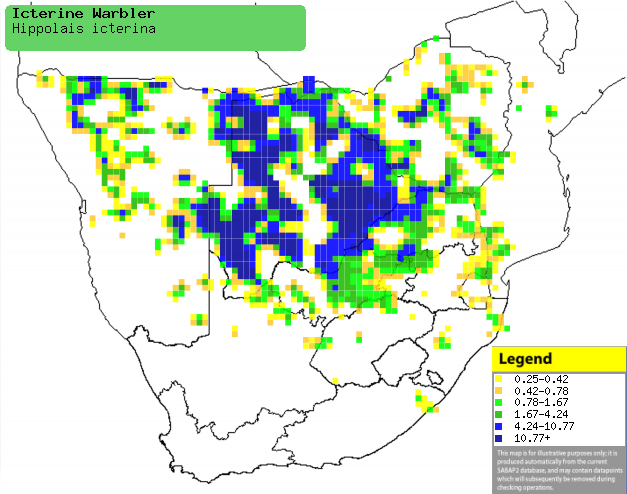|
Hippolais icterina (Icterine
warbler)
Spotsanger [Afrikaans]; Niini (generic term for
warblers and eremomelas) [Kwangali]; Timba (generic name for cisticolas
and warblers) [Shona]; Spotvogel [Dutch]; Hypolaïs ictérine [French];
Gelbspötter [German]; Felosa-icterina [Portuguese]
Life
> Eukaryotes >
Opisthokonta
> Metazoa (animals) >
Bilateria >
Deuterostomia > Chordata >
Craniata > Vertebrata (vertebrates) > Gnathostomata (jawed
vertebrates) > Teleostomi (teleost fish) > Osteichthyes (bony fish) > Class:
Sarcopterygii (lobe-finned
fish) > Stegocephalia (terrestrial
vertebrates) > Tetrapoda
(four-legged vertebrates) > Reptiliomorpha > Amniota >
Reptilia (reptiles) >
Romeriida > Diapsida > Archosauromorpha > Archosauria >
Dinosauria
(dinosaurs) > Saurischia > Theropoda (bipedal predatory dinosaurs) >
Coelurosauria > Maniraptora > Aves
(birds) > Order: Passeriformes
> Family: Sylviidae > Genus: Hippolais
Distribution and habitat
Its breeds in a band from central and northern Europe to
central Asia; In the non-breeding season it heads south to sub-Saharan Africa,
where it occurs from Senegal to Ethiopia south to southern Africa. Here it is
locally common in arid and semi arid woodlands, especially Acacia,
broad-leaved and mixed woodland types.
|
 |
|
Distribution of Icterine warbler in southern
Africa, based on statistical smoothing of the records from first SA Bird
Atlas Project (©
Animal Demography unit, University of
Cape Town; smoothing by Birgit Erni and Francesca Little). Colours range
from dark blue (most common) through to yellow (least common).
See here for the latest distribution
from the SABAP2. |
Movements and migrations
It leaves its breeding grounds from mid July to
early September; as it flies southwards individuals gradually start
settling in African countries until eventually it reaches southern
Africa. Typically it arrives in the north of this region during late
October, with most arrivals happening in November-December. It
usually departs from late March to early April, sometimes earlier.
Food
It mainly eats insects, gleaning them from leaves and
branches in the tree canopy and occasionally hawking them aerially.
Breeding
Southern Africa forms part of its non-breeding grounds, so
know breeding attempts have been recorded. However, a strange observation was
made in 1989 of two Icterine warblers feeding Southern white-crowned chicks,
mobbing their parents when they arrived at the nest.
Threats
Not threatened, in fact its population is estimated to be
several million pairs.
References
-
Hockey PAR, Dean WRJ and Ryan PG 2005. Roberts
- Birds of southern Africa, VIIth ed. The Trustees of the John Voelcker
Bird Book Fund, Cape Town.
-
Harrison, J.A., Allan, D.G., Underhill, L.G., Herremans, M.,
Tree. A.J., Parker, V. & Brown, C.J. (eds). 1997. The atlas of southern
African birds. Vol. 2: Passerines. BirdLife South Africa, Johannesburg.
|
